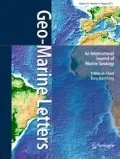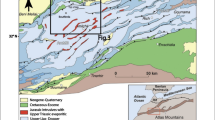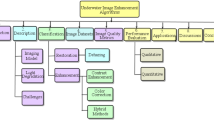Abstract
Factors such as non-uniform illumination of seafloor photographs and partial burial of polymetallic nodules and crusts under sediments have prevented the development of a fully automatic system for evaluating the distribution characteristics of these minerals, necessitating the involvement of a user input. A method has been developed whereby spectral signatures of different features are identified using a software ‘trained’ by a user, and the images are digitized for coverage estimation of nodules and crusts. Analysis of >20,000 seafloor photographs was carried out along five camera transects covering a total distance of 450 km at 5,100–5,300 m water depth in the Central Indian Ocean. The good positive correlation (R2 > 0.98) recorded between visual and computed estimates shows that both methods of estimation are highly reliable. The digitally computed estimates were ∼10% higher than the visual estimates of the same photographs; the latter have a conservative operator error, implying that computed estimates would more accurately predict a relatively high resource potential. The fact that nodules were present in grab samples from some locations where photographs had nil nodule coverage emphasises that nodules may not always be exposed on the seafloor and that buried nodules will also have to be accounted for during resource evaluation. When coupled with accurate positioning/depth data and grab sampling, photographic estimates can provide detailed information on the spatial distribution of mineral deposits, the associated substrates, and the topographic features that control their occurrences. Such information is critical for resource modelling, the selection of mine sites, the designing of mining systems and the planning of mining operations.






Similar content being viewed by others
References
Anonymous (1982) Assessment of manganese nodule resources: the data and the methodologies. UNOET Branch. Graham and Trotman, London
Banerjee R, Mukhopadhyay R (1991) Nature and distribution of manganese nodules from three sediment domains of the Central Indian Basin, Indian Ocean. Geo-Mar Lett 11(1):39–43. doi:10.1007/BF02431053
Banerjee R, Miura H (2001) Distribution pattern and morphochemical relationships of manganese nodules from the Central Indian Basin. Geo-Mar Lett 21(1):34–41. doi:10.1007/s003670100065
Banerjee R, Iyer SD, Dutta P (1991) Buried nodules and associated sediments from the Central Indian Basin. Geo-Mar Lett 11(2):103–107. doi:10.1007/BF02431037
Borowski C (2001) Physically disturbed deep-sea macrofauna in the Peru Basin, southeast Pacific, revisited 7 years after the experimental impact. Deep-Sea Res II 48:3809–3839
Chakraborty B, Kodagali V (2004) Characterizing Indian Ocean manganese nodule-bearing seafloor using multi-beam angular backscatter. Geo-Mar Lett 24(1):8–13. doi:10.1007/s00367-003-0153-y
Cronan DS (1980) Underwater minerals. Academic, London
Cronan DS (2000) Handbook of marine mineral deposits. CRC, London
Edgerton HE (1967) The instruments of deep-sea photography. In: Hersey JB (ed) deep-sea photography. Hopkins, Baltimore, pp 47–54
Edwards BD, Dartnell P, Chezar H (2003) Characterisation benthic substrates of Santa Monica Bay with seafloor photography and multibeam sonar imagery. Mar Environ Res 56:47–66
ERDAS (1991) ERDAS imagine tour guides. ERDAS, Atlanta
Ewing M (1946) Photography of the ocean bottom. Optical Soc Am J 36:307–321
Felix D (1980) Some problems in making nodule abundance estimates from sea floor photographs. Mar Mining 2:293–302
Fewkes RH, McFarland WD, Reinhart WR, Sorem RK (1979) Development of a reliable method for evaluation of deep sea manganese nodule deposits. National Technical Information Service, US Department of Commerce, Bureau Mines Open File Rep 64–80
Frazer JZ, Fisk MB, White M, Wilson L (1978) Availability of Cu, Ni, Co and Mn from ocean ferromanganese nodules. Scripps Inst Oceanogr ref no 78–25
Glasby GP, Singleton RJ (1967) Underwater photographs of manganese nodules from the Southwestern Pacific Basin. N Z J Geol Geophys 18(4):597–604
Grizzle RE, Brodeur MA, Abeels HA, Greene JK (2008) Bottom habitat mapping using towed underwater videography: subtidal oyster reefs as an example application. J Coastal Res 24(1):103–109
Handa K, Tsurusaki K (1981) Manganese nodules: relationship between coverage and abundance in the northern part of Central Pacific Basin. In: Deep Sea Mineral Resources Investigation in the Northern Part of Central Pacific Basin, Geological Survey of Japan, cruise rep no 15, pp 184–217
Heezen BC, Hollister CD (1971) The face of the deep. Oxford University Press, New York
Iyer SD, Sharma R (1990) Correlation between occurrence of manganese nodules and rocks in a part of the Central Indian Ocean Basin. Mar Geol 92(1/2):127–138
Jauhari P (1989) Variability of Mn, Fe, Ni, Cu and Co in manganese nodules from the Central Indian Ocean Basin. Mar Geol 86:237–242
Jauhari P, Iyer SD (2008) A comprehensive view of manganese nodules and volcanics of the Central Indian Ocean Basin. Mar Georesources Geotechnol 26:231–258
Jauhari P, Kodagali VN, Sankar SJ (2001) Optimum sampling interval for evaluating ferromanganese nodule resources in the central Indian Ocean. Geo-Mar Lett 21(3):176–182. doi:10.1007/s00367-001-0081-7
Jung H-S, Ko Y-T, Chi S-B, Moon J-W (2001) Characteristics of seafloor morphology and ferromanganese nodule occurrence in Korea Deep-sea Environmental Study (KODES) area, NE Equatorial Pacific. Mar Georesources Geotechnol 191:167–180
Kodagali V (1988) Influence of regional and local topography on the distribution of polymetallic nodules in Central Indian Ocean Basin. Geo-Mar Lett 8(3):173–178. doi:10.1007/BF02326094
Kodagali VN, Sudhakar M (1993) Manganese nodule distribution in different topographic domains of the Central Indian Basin. Mar Georesources Geotechnol 11:293–309
La Fond EC (1962) Deep current measurements with the bathyscaph Trieste. Deep-Sea Res 9:115–116
Lenoble JP (1982) Technical problems in ocean mining evaluation. In: Varentsov IM, Grasselly GY (eds) Geology and geochemistry of manganese, vol III. Hungarian Academy of Science, Budapest, pp 327–342
Park CY, Kang JK, Kim CW, Park SH (1997) Estimation of coverage and size distribution of manganese nodules based on image processing techniques. In: Proc 2nd Ocean Mining Symp, 24–26 November 1997, Seoul, Korea, pp 40–44
Sankar JS, Sharma RS (2005) An interactive end-user software application for deep sea photographic database. Computers Geosci 31:718–734
Scrutton RA, Talwani M (1982) The ocean floor. Wiley, New York
Sharma R (1989a) Effect of sediment-water interface ‘boundary layer’ on exposure of nodules and their abundance: a study from seabed photos. J Geol Soc India 34:310–317
Sharma R (1989b) Computation of nodule abundance from sea bed photos. In: Proc The 21st Offshore Technology Conf, 1–4 May 1989, Houston, TX, pp 201–212
Sharma R (1993) Quantitative estimation of seafloor features from photographs and their applications to nodule mining. Mar Georesources Geotechnol 11:311–331
Sharma R, Kodagali VN (1993) Influence of seabed topography on distribution of nodules and associated features in Central Indian Ocean: a study based on seabed photographs. Mar Geol 110:153–162
Sharma R, Sankar M, Sudhakar M, Ramprasad T (1995) Integration of deeptow data for mapping of deepsea resources. In: Proc 1st ISOPE Ocean Mining Symp, 21–22 November 1995, Tsukuba, Japan, pp 105–111
Shipek CJ (1960) Photographic study of some deep-sea floor environments in the eastern Pacific. Geol Soc Am 71(7):1067–1074
Vineesh TC, Nath BN, Banerjee R, Jaisankar S, Lekshmi V (2009) Manganese nodule morphology as indicators for oceanic processes in the Central Indian Basin. Int Geol Rev 51:27–44
Yamazaki T, Sharma R (1998) Distribution characteristics of Co-rich manganese deposits on a seamount in the Central Pacific Ocean. Mar Georesources Geotechnol 16:283–305
Yamazaki T, Sharma R (2000) Morphological features of Co-rich manganese deposits and their relation to seabed slopes. Mar Georesources Geotechnol 18:43–76
Yamazaki T, Sharma R, Tsurusaki K (1994) Microtopographic analysis of Co-rich manganese deposits on a mid-Pacific seamount. Mar Georesources Geotechnol 12:33–52
Acknowledgements
This study was carried out under the Environmental studies for polymetallic nodule mining funded by the Ministry of Earth Sciences, Govt. of India. This paper is NIO contribution no. 4695.
Author information
Authors and Affiliations
Corresponding author
Electronic supplementary materials
Below is the link to the electronic supplementary material.
ESM 1
(PDF 4391 kb)
Rights and permissions
About this article
Cite this article
Sharma, R., Sankar, S.J., Samanta, S. et al. Image analysis of seafloor photographs for estimation of deep-sea minerals. Geo-Mar Lett 30, 617–626 (2010). https://doi.org/10.1007/s00367-010-0205-z
Received:
Accepted:
Published:
Issue Date:
DOI: https://doi.org/10.1007/s00367-010-0205-z




